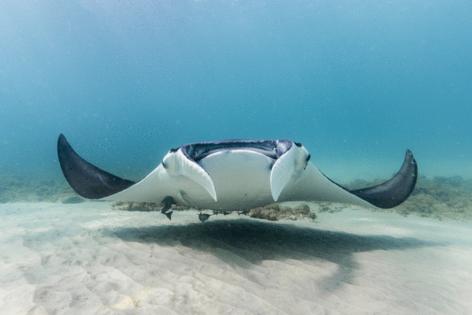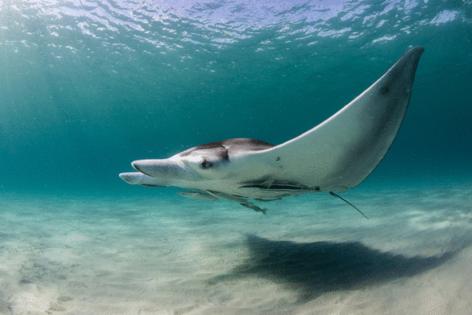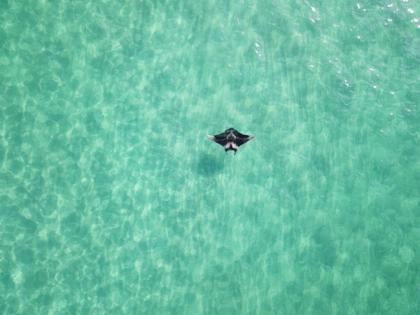Florida allowed capture of threatened giant manta ray for overseas aquarium
Published in Science & Technology News
ORLANDO, Fla. — Denis Richard watched five men heave a giant manta ray from the waters off Panama City Beach and plop it into a pool on their boat deck.
“Let him go,” he yelled. “You ought to be ashamed of yourselves.”
Richard, a dolphin tour boat operator, was outraged that a threatened species often called the “angel of the sea” could be plucked from Florida’s waters. But the capture was legal: State wildlife officials issued a special permit allowing a giant manta ray to be taken for SeaWorld Abu Dhabi, which bills itself as the world’s largest indoor marine life theme park.
The park in the Middle East — about 7,800 miles away from the manta ray’s Florida home — contracted with a Florida Keys aquarium supplier to capture the creature, according to records obtained by the Orlando Sentinel. The fate of the manta ray could not be determined as neither SeaWorld Abu Dhabi nor the supplier responded to requests for information.
Video footage of the animal’s July 12 capture, posted online, has reignited debate over whether these intelligent, migratory creatures belong in captivity. Just a handful of aquariums in the world display manta rays, and Florida is the only U.S. state that allows their harvest, according to a 2024 federal report.
Richard, founder and CEO of the Water Planet USA dolphin tour company, said he witnessed the capture while leading a tour, and one of his crew members filmed it.
He initially thought the men had caught a shark until he saw the winged body struggling in the net. His concern grew when he later learned the manta ray appeared destined for the aquarium in the Middle East.
“The risks of that manta ray being traumatized and possibly dying in that process are very high because they are a very sensitive species,” Richard said.
Known for impressing divers with its graceful movements, the giant manta ray is classified as a threatened species under the U.S. Endangered Species Act. With a wingspan up to 26 feet, it can grow to 5,300 pounds, about as much as a car.
Florida generally prohibits catching manta rays. But the state can authorize a special license to capture them for educational, exhibition and research purposes with the objective of increasing “the public’s knowledge and awareness of Florida’s marine resources.”
The July 12 capture was authorized under such a license issued by the Florida Fish and Wildlife Conservation Commission. The agency permitted the collection of one giant manta ray from state waters for exhibition purposes, according to the company’s license, which was valid for a year starting Nov. 1.
Over the past two years, state wildlife officials have issued four such licenses to various entities, agency spokeswoman Shannon Knowles said in a statement. One manta ray died shortly after being taken into captivity, she said.
Florida is the only state that authorizes giant manta ray harvest for aquarium and exhibition purposes, according to a 2024 report from the National Oceanic and Atmospheric Administration’s fisheries division. From 2019 to 2022, Florida issued 17 exhibition licenses to aquariums in China, France, the United Arab Emirates and Maryland, the report found.
Those aquariums weren’t successful in capturing a manta ray during that timeframe, but the number of licenses suggests increasing interest around the world, according to the report.
Richard uploaded video footage of the encounter to social media, garnering more than one million views and stoking outrage. South Florida’s WPLG Local 10 news reported on the viral video, generating more attention.
“How is this allowed? These animals aren’t meant for tanks,” one commenter wrote. “They belong in the ocean. Absolutely unacceptable!”
Others defended the capture, saying aquariums connect the public with the oceans and raise money for conservation and research.
It’s unclear what SeaWorld Abu Dhabi’s plans are for the manta ray. Company officials did not respond to multiple requests for comment. SeaWorld Abu Dhabi opened in May 2023 in the capital city of the United Arab Emirates. Manta rays are among the marine life that can be viewed at the aquarium, according to promotional materials advertising the park on Experience Abu Dhabi.
Records show SeaWorld Abu Dhabi contracted with Dynasty Marine Associates, a company based in Marathon in the Florida Keys, to capture the manta ray. In a 2012 article, Coral magazine described Dynasty Marine as “the preeminent purveyor of large and rare saltwater specimens” for public aquariums around the globe.
Dynasty Marine is likely the nation’s sole exporter of manta rays with three specimens exported in the past six to eight years, the company’s president, Christopher Ben Daughtry, wrote to federal regulators in January. His letter urged regulators to support the export of manta rays for display in aquariums.
“Our specimens are viewed by millions of visitors each year and are ambassadors for their species, teaching the public the value of conserving the oceans and the wild populations of this charismatic megafauna,” he wrote.
Transporting a manta ray is extremely complex, costing tens of thousands of dollars and requiring the use of oxygenated tanks, he added. The company devotes the “utmost care and attention” to protecting the health and welfare of specimens, Daughtry said.
Only about six aquariums worldwide are known to keep manta rays, according to a federal report. The Georgia Aquarium in Atlanta is the only one in the United States.
Keeping giant manta rays in aquariums is challenging. Giant manta rays must constantly swim and cover significant distances during seasonal migrations. As filter feeders, they consume plankton and other small organisms extracted from the water. They are slow-growing, giving birth to only one pup every two to three years. Gestation is thought to last around a year. They have been reported to live at least 45 years.
Jessica Pate, founder of the Florida Manta Project, said she agrees aquariums can be powerful educational tools, but she doesn’t support taking manta rays from the wild.
“Manta rays are capable of migrating hundreds of miles and have the biggest brain of any fish, likely indicating their intelligence,” said Pate, lead scientist and project manager at the Marine Megafauna Foundation.
A 2016 study found that a manta ray was capable of recognizing itself in the mirror. Only a small number of species, mostly primates, have passed the so-called mirror test, a behavior associated with self-awareness.
Threatened species don’t automatically receive the same level of protection under federal law as endangered species, which are considered to be at a higher risk of extinction.
As a result, there are no “take” prohibitions for the threatened giant manta ray, and extended protections have not been issued, said James Miller, a spokesman for NOAA Fisheries.
Manta rays face a variety of threats, including entanglement in fishing gear, vessel strikes and pollution. There is also a demand for their gill plates, which are touted in Asian markets as having medicinal benefits.
On its website, SeaWorld Abu Dhabi promises that it is “committed to providing the highest standard of animal welfare” and is dedicated to marine research, conservation and education.
But Richard said he thinks there are alternatives that could instill an appreciation of manta rays without taking them from the wild. One idea, he said, is to showcase the manta ray’s majesty through virtual reality.
“The purpose of that capture is to make money for display,” Richard said. “That animal is going to spend the rest of her life in captivity swimming in a circle.”
---------------
©2025 Orlando Sentinel. Visit at orlandosentinel.com. Distributed by Tribune Content Agency, LLC.












Comments